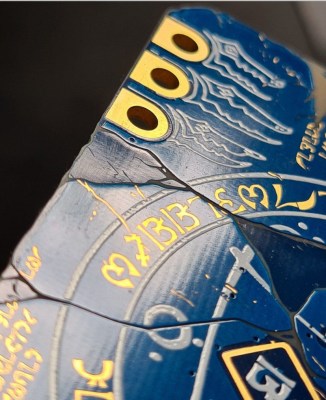

One effect of the global pandemic was that there were relatively few events in our sphere for a couple of years. This and that other by-product of COVID-19, the chip shortage, meant that over the past year we’ve been treated to several event badges that should have appeared in 2020 or 2021, but didn’t due to those cancelled events. We were lucky enough to receive probably the last of these delayed badges in mid February, as we made the journey to the central part oft he Netherlands to Hacker Hotel 2023.
A Puzzle, A 4-Bit Computer, And An Artwork
The badge takes the form of a rectangular PCB with all parts on the top side. The brains of the operation is an RP2040, and it’s powered by a CR2032 coin cell in a holder. It’s divided into two parts, the top third which carries the circuitry and the lower two thirds of which as a row of buttons and LEDs. It’s pretty obvious from the start that it has data and address lines of a 4-bit computer, and as well as these there is an evident serial port and a USB socket. The artwork comes form the same artist whose work graced both the previous Hacker Hotel badge and the MCH2022 badge, and the rear of the PCB makes full use of all layers to create a mystical puzzle. The sum is to create a puzzle game intended to entertain the visitor, take them round the venue, and find clues to an eventual solution. I love the design both from an artistic and technical viewpoint, but have to admit that the puzzle aspect isn’t really my thing. Thus here we’ll concentrate on the badge hardware and production, and mention the puzzles only in passing.

For those interested in the full story, there’s a badge talk you can watch on YouTube, which we’ve embedded below. The designer [Pim] outlines the early steps before the hammer blows of pandemic and component shortages, before the selection of the RP2040. The artist [Nicolett] goes into the detail behind the design, inspired by ancient grave markers, and the genesis of the puzzles. The colour was chosen as a deep blue, inspired by lapis lazuli.
With a design ready for December 2021 as the 2022 event date in February approached, they received another bombshell; the event was once more cancelled due to the pandemic. This however left them in the enviable position of having their badge ready a year early for the 2023 event, with a first prototype in hand. A year later they were able to order the badge production run, and with a minor hiccup of a misplaced diode footprint they were ready to go with a full production run. In practice though, none of the new badges worked. An emergency parcel from China brought samples, and after some anxious debugging they found their flash chips already contained strings and had been set as read-only. Fortunalely Alnet were able to rework them, but it serves as a lesson for anyone considering a remote production run.
Over the weekend there was a constant view of participants bending over their badges, finding clues around the hotel, entering binary code from the event lanyard, and even playing a serial port text adventure game. The participants seemed to be enjoying the challenges, and I know that more than one person solved all the puzzles and received an amulet as a reward.
The idea of a 4-bit computer on a badge isn’t entirely new, but it makes for an interesting diversion. I particularly like the way the copper layer has been used on the rear of the badge to give a cracked stone effect, and as always a lot of effort went into the design. If I have a criticism of this badge it is that it has little utility beyond the event, however it remains an attractive piece of artwork for participants to display. If you’re interested in delving further, everything can be found on GitHub, where we’re also promised more about the puzzles.
Now that the lingering effects of the pandemic have lifted from the world of hacker events, we look forward to seeing what new badges 2023 brings.

